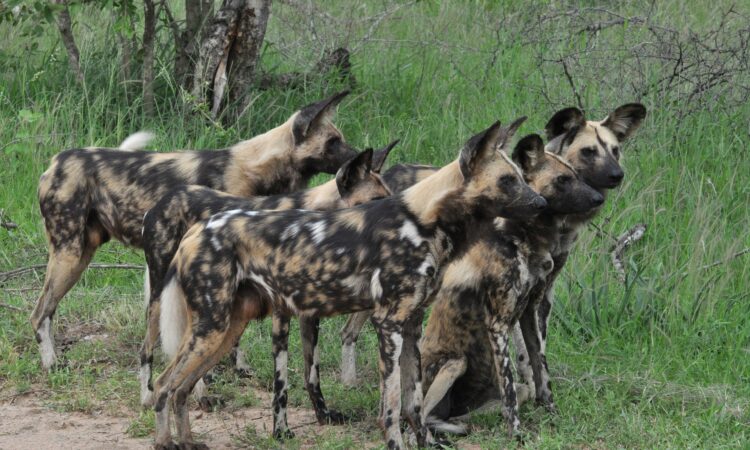Sighting African Wild Dogs in Kidepo Valley National Park: Wild dogs, sometimes known as African painted dogs, have been spotted in Uganda’s Kidepo Valley National Park after being presumed locally extinct since the 1980s. This sighting, particularly along the Narus River, is considered a huge conservation victory for Uganda.

Fun facts about the African Wild Dog.
- The African wild dog is an excellent hunter. By hunting in groups, they catch 80-90% of their prey. Compare this to a lion, the jungle king, who only captures one-third of its prey!
- African wild dogs are carnivorous animals and only feed on fresh meat like impala, eland, gazelles, wildebeest, and springbok (although there aren’t any wildebeests and springbok in Kidepo Valley National Park).
- The average African wild dog weighs between 20-32kg and has a shoulder height of 75cm.
- The gestation period for the female African wild dog is 2.5 months, and they can give birth to 7-10 puppies.
Perhaps you’ll see the dogs when they’re hungry and ready to hunt. However, it will most likely be a long hunt. You may not be able to follow everything since the dogs encircle their prey and approach it from multiple directions.
About Kidepo Valley National Park
Spanning over a radius of 1,444 square kilometers, Kidepo Valley National Park is Uganda’s third-largest national park and brims with an abundance of wildlife species, making it the perfect destination for an African safari.
Kidepo Valley National Park, located in northeastern Uganda and bordered by South Sudan and Kenya, is not particularly frequented by tourists in Uganda due to its far location from the capital- Kampala. Despite its violent past, the park still invites daring visitors seeking an untamed and unknown African experience away from the typical safari throng. It is a tough ten-hour trip from Uganda’s capital, Kampala, but as a result, the park has the feel of a hidden jewel.
The Narus River, which cuts through the park, and the Kidepo River, which is prone to flash floods, draw enormous herds of buffalo, crocodiles, and birds. These rivers provide fantastic chances for wildlife and bird watching. To the west and southeast of the park, wooded mountains rise to more than 2,740 metres. The scenery is best described as broad savannahs with both long and short grasses, similar to Kenya’s Maasai Mara, and interspersed with borassus palms and sausage trees.
Several plant types contribute to the abundance of this diversified terrain, including the distinctive acacia-dominated plains, fire-climax grasslands, wetlands, tree- and shrub-steppe, thickets, and woods. The savannah is also disturbed by occasional rough granite outcrops. To the west, the terrain merges completely with the Napore Nyagia Hills, while the Lokayot and Natira Hills separate the two valleys to the east.
The local populations around Kidepo’s cultural history are made up of the cattle-herding Karamojong people, who are said to have moved from Ethiopia in 1600AD, and the hunter-gatherer Ik tribe, a tiny group that lives on the slopes of Mount Morungole.
Attractions in Uganda’s Kidepo Valley National Park.
Although Kidepo is well-known for its diverse bird population, which includes several stunning endemics, it also has breathtaking, expansive, and undulating landscapes, as well as plentiful animals. If seeing the hues of Africa is on your bucket list, Kidepo is the place to go.
The amber of a lion resting in the long, pink grasses at dusk, the patchwork chessboards of brown and green as Rothschild giraffes sway among the thorn trees, and the multi-hued feathery magnificence of 470 bird species all contribute to a colorful palette.
Boasting over 86 mammal species to choose from, including buffalo, bat-eared foxes, aardvarks, and zebras, game drives at Kidepo Valley National Park will never be boring. Four of the Big Five may be seen here (rhinos are absent), and there are hopes to reintroduce white rhinos to the park. It also serves as a sanctuary for predators, both mammalian and avian. The most prevalent carnivores are side-striped jackals, with black-backed equivalents seen in drier locations.
Lions, leopards, and spotted hyenas may provide you a glimpse of a kill in progress, especially during the dry season when the animals congregate at the few surviving puddles along the riverbanks. The vast savannahs, dotted with termite mounds and rocky outcrops, are ideal for cheetahs to chase their favored prey, the oribi. The pygmy falcon, Verreaux’s eagle, Egyptian vulture, grey kestrel, lesser kestrel, fox kestrel, pallid harrier, and white-faced scops owl are all birds of prey.

Wildlife Species found in Kidepo Valley National Park.
Antelope species include Jackson’s hartebeest, eland, bushbuck, Defassa waterbuck, kudu, Chandler’s mountain reedbuck, bohor reedbuck, oribi, Guenther’s dik-dik, Uganda kob, and, if you’re lucky, Bright’s gazelle, a subspecies of Grant’s.
Bird species found in Kidepo Valley National Park.
Kidepo’s birds are a major draw, since it has the second-highest bird population of any Ugandan protected area and is designated as an Important Bird Area, sustaining Somali-Maasai and Sudan-Guinea biome endemics. Many specialties are even found at the park’s campgrounds. The Karamoja Apalis, Jackson’s hornbill, and black-breasted barbet are all fascinating ‘specials’ that leave birders in awe.
Among the feathered pleasures are the golden pipit, which flits like a comet, the silver bird flycatcher, the splendid starling with iridescent plumage, the scarlet-chested sunbird, and the appropriately called gorgeous sunbird, which is a rainbow on wings. Clapperton’s spur fowl, yellow-necked spur fowl, white-headed buffalo weaver, steel-blue whydah, rose-ringed parakeet, and enormous herds of ostriches may all be seen here.
Best Time to Visit Uganda’s Kidepo Valley National Park.
The park operates in two seasons. The hot, dry season runs from October to March, when the rivers (excluding Narus river) dry up and the grasslands grow shorter. This is the greatest time to watch wildlife since the animals are drawn to the few surviving waterholes and are visible through the low grass. Rain pours throughout the rainy season, which lasts from April to September and may total up to 890mm, making roadways difficult to maneuver. During this period, animals withdraw to the thicker forests.
If you stumble into this Kidepo Valley National Park predator, enjoy the experience and spend as much time as possible observing it. You have no idea when you will see one again.


